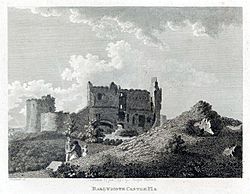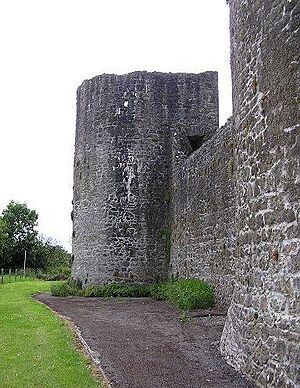Ballymote Castle facts for kids
Quick facts for kids Ballymote Castle
|
|
|---|---|
| Irish: Caisleán Bhaile an Mhóta | |
| County Sligo, Connacht Near Ballymote in Ireland |
|

The castle in the 1790s
|
|
|
Location in Ireland
|
|
| Coordinates | 54°5′14.28″N 8°31′14.52″W / 54.0873000°N 8.5207000°W |
| Type | Norman castle |
| Site information | |
| Owner | Office of Public Works |
| Open to the public |
No |
| Condition | Ruined |
| Site history | |
| Built | 1300ish |
| Built by | Richard de Burgh |
| In use | 1300-Late 17th Century |
| Fate | Fell into Ruin |
| Battles/wars | Irish Nine Year's War |
Ballymote Castle (Irish: Caisleán Bhaile an Mhóta) is a large, rectangular castle built around the year 1300. It is located near the town of Ballymote in County Sligo, Ireland. This area was once called Átha Cliath an Chorainn. This name means The Ford of the Hurdles of Corann.
Ballymote Castle is the last Norman castle built in the area of Connacht. It was likely built by Richard Óg de Burgh, 2nd Earl of Ulster, also known as the Red Earl. He built it to protect the lands he had recently gained in County Sligo.
Contents
Building a Strong Castle
Ballymote Castle is a large enclosure castle. It is very balanced in its design. It looks a lot like Beaumaris Castle in Wales. That castle was built by King Edward I of England.
The main entrance to Ballymote Castle is on the north side. It has a gatehouse with two D-shaped towers. The outer parts of this gatehouse are mostly gone today. But the castle itself is still very impressive. The inside area of the castle is about 30 square meters (323 square feet).
There are round towers at each of the four corners of the castle. There are also towers in the middle of the east and west walls. A secret back gate, called a postern gate, was planned for the south wall. However, it was never finished. This was probably because the castle was lost to the O'Connors in 1317. A small square tower was meant to protect this gate.
The castle walls are about 3 meters (10 feet) thick. Six large towers stand along these walls. Inside the walls, there are narrow passages about 1 meter (3 feet) wide. These passages connect to the towers and the main walls at different heights. This design made it easy to defend the castle.
We don't know what the buildings inside the castle looked like. No traces of them remain today.
Local stories say that secret tunnels connected the castle to Emlaghfad church. They also say tunnels led to the nearby Franciscan Abbey. However, these kinds of stories are common in Ireland and are probably not true.
The Red Earl is also believed to have built an old road. This road went from Boyle, County Roscommon to Collooney. It was known as Bóthar an Corann or the Red Earls Road.
A Castle with Many Owners
Ballymote Castle changed hands many times over the years.
- In 1317, the O'Connors of Sligo captured it.
- In 1347, the Mac Diarmada family took it during local fights.
- By 1381, the McDonaghs owned the castle.
In 1561, Tadhg MacDermot, a king from Moylurg, owned it. But by 1571, it belonged to the O'Connor Sligo. He gave the castle to James I of England and then got it back as a gift.
In 1577, the English held the castle for a short time. They took it more permanently in 1584. This was when Richard Bingham, the Governor of Connacht, captured it. It seems the castle was mostly empty between 1317 and 1584.
In 1588, the O'Connors, O'Hartes, and O'Dowds attacked the castle. The English gave it up in 1598 to the MacDonaghs. They then sold it to Red Hugh O'Donnell. Some say he bought it for £400 and 300 cows!
Red Hugh O'Donnell marched from Ballymote Castle to the terrible Battle of Kinsale in 1601. When the O'Donnells gave the castle to the English in 1602, it was already in poor condition.
In 1633, the Taaffes owned it briefly. But they had to surrender it to the English Parliament's forces in 1652. During the Williamite wars, Captain Terence MacDonagh held the castle for King James II. However, he had to give it up to Lord Granard in 1690 after an artillery attack.
Soon after, the castle's defenses were removed. The moat was filled in, and the castle became a ruin.
In recent years, the Office of Public Works has worked to preserve the castle.
Visiting Ballymote Castle
The castle is located on the R296 road. This road goes from Ballymote to Tubbercurry. It is right across from the Ballymote railway station. You can reach it through the grounds of the Ballymote Community nursing unit.
Sadly, you cannot go inside the castle right now. The Office of Public Works has said it is not safe for visitors.
Images for kids






